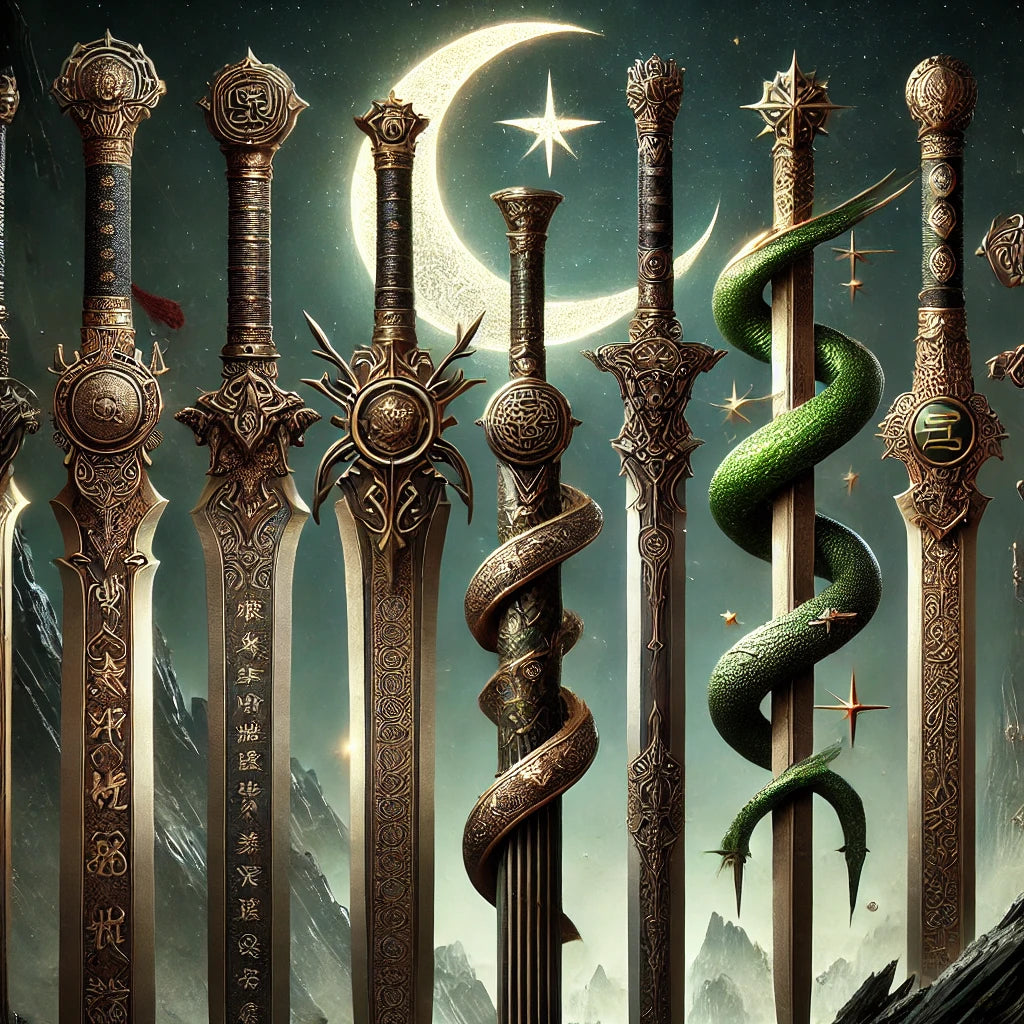
Legendary Swords and Stories
Share
Introduction
Chinese swords and knives are not only revered for their craftsmanship and historical significance but also for the legendary tales and cultural narratives that surround them. These blades often serve as central elements in myths, folklore, and classical literature, embodying virtues such as honor, bravery, and wisdom. This section explores some of the most legendary Chinese swords and the captivating stories that have immortalized them. Additionally, it delves into the portrayal of swords in Chinese literary works, highlighting their symbolic and narrative roles.
1. Legends and Stories of Famous Swords
1.1 The Sword of Goujian
Overview: The Sword of Goujian is an ancient Chinese bronze sword dating back to the Spring and Autumn period (771–476 BCE). It is renowned for its exceptional craftsmanship and remarkable preservation.
Legend: According to legend, the sword belonged to King Goujian of Yue, who used it to reclaim his kingdom after years of hardship and exile. The sword symbolizes perseverance and resilience, embodying King Goujian's determination to restore his kingdom's glory.
Historical Significance: The Sword of Goujian is celebrated for its intricate design and superior metallurgy. It remains a symbol of ancient Chinese sword-making excellence and strategic military prowess.
1.2 Green Dragon Crescent Blade (Guan Yu's Weapon)
Overview: The Green Dragon Crescent Blade, also known as the Guan Dao, is a legendary weapon attributed to the famed general Guan Yu from the Three Kingdoms period (220–280 CE).
Legend: Guan Yu is said to have wielded this massive, single-edged saber with unparalleled skill, earning him the nickname "Flying General." The blade's size and craftsmanship were unmatched, making it a symbol of his strength and loyalty.
Cultural Legacy: The Green Dragon Crescent Blade is immortalized in the classic novel "Romance of the Three Kingdoms," where it represents Guan Yu's martial prowess and noble character. It remains a revered symbol in Chinese culture, often associated with bravery and righteousness.
1.3 The Seven-Star Sword
Overview: The Seven-Star Sword is a mythical blade believed to possess magical properties and celestial significance.
Legend: According to folklore, the Seven-Star Sword was forged under the light of the Big Dipper constellation, granting it the power to control the elements and protect its wielder from evil forces. It is often depicted as a weapon of divine origin, used by heroes in epic battles against dark forces.
Symbolism: The sword symbolizes cosmic harmony and the balance between good and evil. Its celestial origins link it to the heavens, emphasizing its sacred and invincible nature.
1.4 The Sword of Sorrow (Wang Zhaojun's Blade)
Overview: The Sword of Sorrow is a poignant artifact associated with the legendary beauty Wang Zhaojun, one of the Four Beauties of ancient China.
Legend: As part of her tragic love story, Wang Zhaojun offered her sword to her husband as a symbol of her enduring love and sorrow. The blade is said to carry the weight of her heartbreak and the sacrifices she made for peace and unity between warring states.
Emotional Significance: The Sword of Sorrow represents themes of love, loss, and duty. It is revered not only as a weapon but also as a testament to personal sacrifice and the pursuit of harmony.
1.5 The Sky Piercer Sword
Overview: The Sky Piercer Sword is a legendary blade known for its extraordinary sharpness and celestial attributes.
Legend: Crafted by celestial blacksmiths, the Sky Piercer Sword was bestowed upon a hero chosen by the heavens to defend the mortal realm from supernatural threats. Its ability to pierce the sky signifies its divine origin and unmatched cutting power.
Mythological Role: The sword is often featured in myths where it is used to vanquish formidable foes, symbolizing divine intervention and the triumph of good over evil.
2. Swords in Chinese Literature
2.1 Swords in "Romance of the Three Kingdoms"
Overview: "Romance of the Three Kingdoms" is one of China's Four Great Classical Novels, rich with tales of heroism, strategy, and legendary weapons.
Depiction of Swords: Swords in the novel are not just tools of war but also symbols of honor and loyalty. Characters like Guan Yu and Zhou Yu wield their blades with both skill and moral integrity, reinforcing the virtues they embody.
Symbolic Importance: The swords in the novel often represent the characters' inner strength and their commitment to their respective causes. They are integral to the narrative, driving key plot developments and character arcs.
2.2 Swords in "Journey to the West"
Overview: "Journey to the West" is a seminal work of Chinese literature that combines mythology, adventure, and spiritual quest.
Role of Swords: The protagonist, Sun Wukong (the Monkey King), wields the Ruyi Jingu Bang, a magical staff that transforms into various weapons, including swords. This versatile weapon underscores his supernatural abilities and strategic ingenuity.
Narrative Function: The magical properties of swords in the story highlight themes of transformation, power, and the overcoming of obstacles. They serve as extensions of the characters' identities and their journey towards enlightenment.
2.3 Swords in "Water Margin"
Overview: "Water Margin," another of China's Four Great Classical Novels, chronicles the adventures of 108 outlaws fighting against corrupt officials.
Swords as Symbols of Rebellion: Swords in "Water Margin" symbolize resistance and the fight for justice. The outlaws use their blades not only for combat but also as emblems of their defiance against tyranny.
Character Development: The skill and prowess with which characters wield their swords reflect their personalities and their roles within the group. The swords often serve as extensions of their courage and determination.
3. Conclusion
The legendary stories and literary depictions of Chinese swords and knives enrich their historical and cultural significance. These blades transcend their functional roles, becoming symbols of virtue, power, and artistry. Through myths, folklore, and classical literature, the stories of these swords continue to inspire and captivate audiences, ensuring that the legacy of Chinese blade craftsmanship endures through the ages. Understanding these narratives deepens our appreciation for the profound impact that these legendary weapons have had on Chinese culture and beyond.
Chinese swords and knives are not only revered for their craftsmanship and historical significance but also for the legendary tales and cultural narratives that surround them. These blades often serve as central elements in myths, folklore, and classical literature, embodying virtues such as honor, bravery, and wisdom. This section explores some of the most legendary Chinese swords and the captivating stories that have immortalized them. Additionally, it delves into the portrayal of swords in Chinese literary works, highlighting their symbolic and narrative roles.
1. Legends and Stories of Famous Swords
1.1 The Sword of Goujian
Overview: The Sword of Goujian is an ancient Chinese bronze sword dating back to the Spring and Autumn period (771–476 BCE). It is renowned for its exceptional craftsmanship and remarkable preservation.
Legend: According to legend, the sword belonged to King Goujian of Yue, who used it to reclaim his kingdom after years of hardship and exile. The sword symbolizes perseverance and resilience, embodying King Goujian's determination to restore his kingdom's glory.
Historical Significance: The Sword of Goujian is celebrated for its intricate design and superior metallurgy. It remains a symbol of ancient Chinese sword-making excellence and strategic military prowess.
1.2 Green Dragon Crescent Blade (Guan Yu's Weapon)
Overview: The Green Dragon Crescent Blade, also known as the Guan Dao, is a legendary weapon attributed to the famed general Guan Yu from the Three Kingdoms period (220–280 CE).
Legend: Guan Yu is said to have wielded this massive, single-edged saber with unparalleled skill, earning him the nickname "Flying General." The blade's size and craftsmanship were unmatched, making it a symbol of his strength and loyalty.
Cultural Legacy: The Green Dragon Crescent Blade is immortalized in the classic novel "Romance of the Three Kingdoms," where it represents Guan Yu's martial prowess and noble character. It remains a revered symbol in Chinese culture, often associated with bravery and righteousness.
1.3 The Seven-Star Sword
Overview: The Seven-Star Sword is a mythical blade believed to possess magical properties and celestial significance.
Legend: According to folklore, the Seven-Star Sword was forged under the light of the Big Dipper constellation, granting it the power to control the elements and protect its wielder from evil forces. It is often depicted as a weapon of divine origin, used by heroes in epic battles against dark forces.
Symbolism: The sword symbolizes cosmic harmony and the balance between good and evil. Its celestial origins link it to the heavens, emphasizing its sacred and invincible nature.
1.4 The Sword of Sorrow (Wang Zhaojun's Blade)
Overview: The Sword of Sorrow is a poignant artifact associated with the legendary beauty Wang Zhaojun, one of the Four Beauties of ancient China.
Legend: As part of her tragic love story, Wang Zhaojun offered her sword to her husband as a symbol of her enduring love and sorrow. The blade is said to carry the weight of her heartbreak and the sacrifices she made for peace and unity between warring states.
Emotional Significance: The Sword of Sorrow represents themes of love, loss, and duty. It is revered not only as a weapon but also as a testament to personal sacrifice and the pursuit of harmony.
1.5 The Sky Piercer Sword
Overview: The Sky Piercer Sword is a legendary blade known for its extraordinary sharpness and celestial attributes.
Legend: Crafted by celestial blacksmiths, the Sky Piercer Sword was bestowed upon a hero chosen by the heavens to defend the mortal realm from supernatural threats. Its ability to pierce the sky signifies its divine origin and unmatched cutting power.
Mythological Role: The sword is often featured in myths where it is used to vanquish formidable foes, symbolizing divine intervention and the triumph of good over evil.
2. Swords in Chinese Literature
2.1 Swords in "Romance of the Three Kingdoms"
Overview: "Romance of the Three Kingdoms" is one of China's Four Great Classical Novels, rich with tales of heroism, strategy, and legendary weapons.
Depiction of Swords: Swords in the novel are not just tools of war but also symbols of honor and loyalty. Characters like Guan Yu and Zhou Yu wield their blades with both skill and moral integrity, reinforcing the virtues they embody.
Symbolic Importance: The swords in the novel often represent the characters' inner strength and their commitment to their respective causes. They are integral to the narrative, driving key plot developments and character arcs.
2.2 Swords in "Journey to the West"
Overview: "Journey to the West" is a seminal work of Chinese literature that combines mythology, adventure, and spiritual quest.
Role of Swords: The protagonist, Sun Wukong (the Monkey King), wields the Ruyi Jingu Bang, a magical staff that transforms into various weapons, including swords. This versatile weapon underscores his supernatural abilities and strategic ingenuity.
Narrative Function: The magical properties of swords in the story highlight themes of transformation, power, and the overcoming of obstacles. They serve as extensions of the characters' identities and their journey towards enlightenment.
2.3 Swords in "Water Margin"
Overview: "Water Margin," another of China's Four Great Classical Novels, chronicles the adventures of 108 outlaws fighting against corrupt officials.
Swords as Symbols of Rebellion: Swords in "Water Margin" symbolize resistance and the fight for justice. The outlaws use their blades not only for combat but also as emblems of their defiance against tyranny.
Character Development: The skill and prowess with which characters wield their swords reflect their personalities and their roles within the group. The swords often serve as extensions of their courage and determination.
3. Conclusion
The legendary stories and literary depictions of Chinese swords and knives enrich their historical and cultural significance. These blades transcend their functional roles, becoming symbols of virtue, power, and artistry. Through myths, folklore, and classical literature, the stories of these swords continue to inspire and captivate audiences, ensuring that the legacy of Chinese blade craftsmanship endures through the ages. Understanding these narratives deepens our appreciation for the profound impact that these legendary weapons have had on Chinese culture and beyond.
